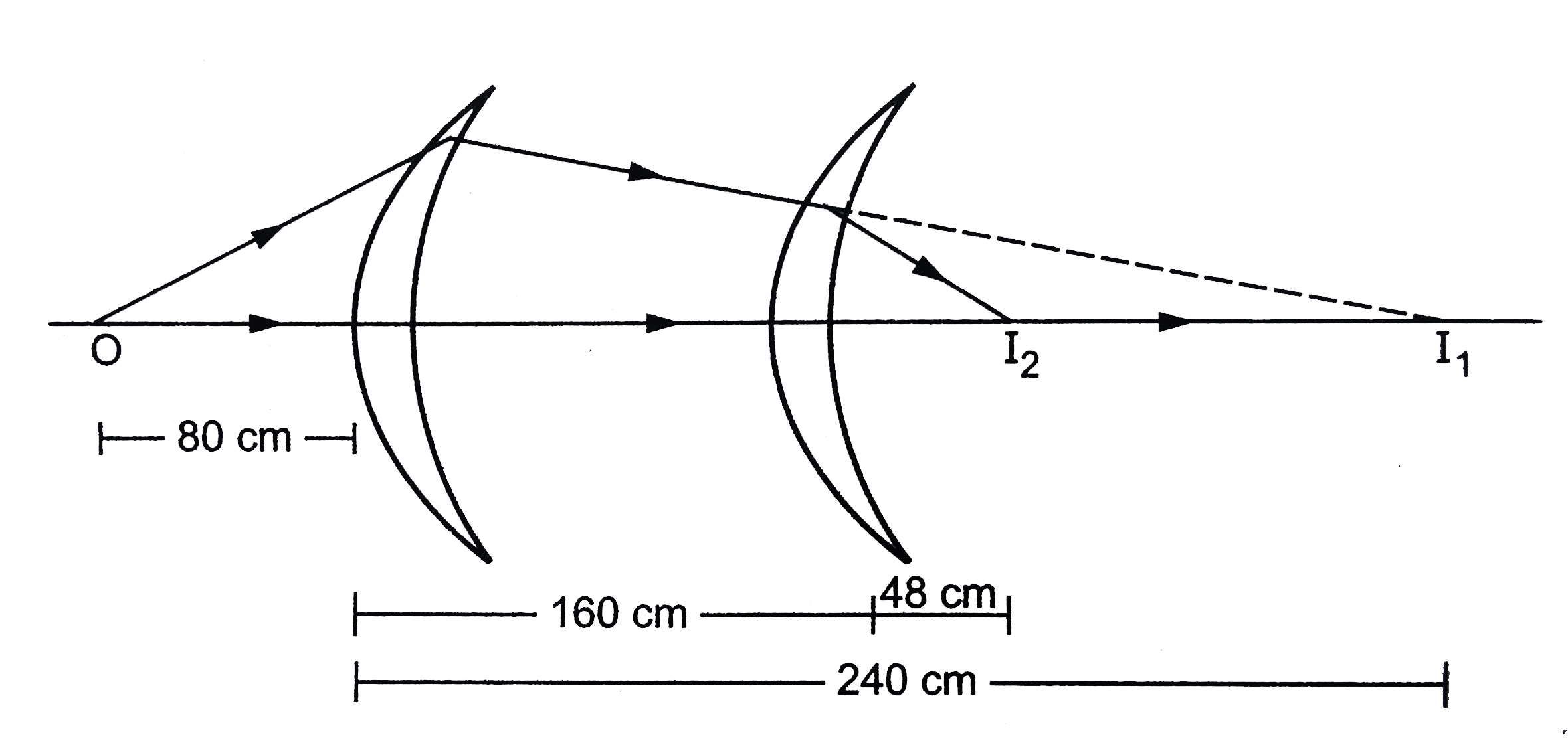A diverging meniscus lens of 1.5 refractive index has concave surfaces of radii 3 and 4 cm. The position of image if an object is placed 12cm infront of the lens is
−24cm
−8cm
8cm
24cm
The correct Answer is:B
To solve the problem of finding the position of the image formed by a diverging meniscus lens, we will follow these steps:
Step 1: Identify the parameters of the lens
- Refractive index (μ) = 1.5
- Radius of curvature of the first surface (R1) = -3 cm (concave surface)
- Radius of curvature of the second surface (R2) = -4 cm (concave surface)
- Object distance (u) = -12 cm (since the object is placed in front of the lens)
Step 2: Use the Lens Maker's Formula to find the focal length (f)
The lens maker's formula is given by:
1f=(μ−1)(1R1−1R2)
Substituting the values:
1f=(1.5−1)(1−3−1−4)
=0.5(−13+14)
Finding a common denominator (12):
=0.5(−412+312)
=0.5(−112)=−124
Thus, the focal length (f) is:
f=−24 cm
Step 3: Apply the Lens Formula to find the image distance (v)
The lens formula is given by:
1f=1v−1u
Substituting the known values:
1−24=1v−1−12
This simplifies to:
1−24=1v+112
Rearranging gives:
1v=1−24−112
Finding a common denominator (24):
1v=−124−224=−324
Thus:
1v=−18
Therefore, the image distance (v) is:
v=−8 cm
Step 4: Interpret the result
The negative sign indicates that the image is formed on the same side as the object, which is typical for a diverging lens.
Final Answer:
The position of the image is at -8 cm.
---
- Refractive index (μ) = 1.5
- Radius of curvature of the first surface (R1) = -3 cm (concave surface)
- Radius of curvature of the second surface (R2) = -4 cm (concave surface)
- Object distance (u) = -12 cm (since the object is placed in front of the lens)
The lens maker's formula is given by:
1f=(μ−1)(1R1−1R2)
Substituting the values:
1f=(1.5−1)(1−3−1−4)
=0.5(−13+14)
Finding a common denominator (12):
=0.5(−412+312)
=0.5(−112)=−124
Thus, the focal length (f) is:
f=−24 cm
The lens formula is given by:
1f=1v−1u
Substituting the known values:
1−24=1v−1−12
This simplifies to:
1−24=1v+112
Rearranging gives:
1v=1−24−112
Finding a common denominator (24):
1v=−124−224=−324
Thus:
1v=−18
Therefore, the image distance (v) is:
v=−8 cm
The negative sign indicates that the image is formed on the same side as the object, which is typical for a diverging lens.
The position of the image is at -8 cm.
Topper's Solved these Questions
- RAY OPTICS AND OPTICAL INSTRAUMENTS BOOK - NARAYNACHAPTER - RAY OPTICS AND OPTICAL INSTRAUMENTS EXERCISE - EXERCISE - 1 (C.W)(REFRACTION THROUGH PRISM)
6 Videos
- RAY OPTICS AND OPTICAL INSTRAUMENTS BOOK - NARAYNACHAPTER - RAY OPTICS AND OPTICAL INSTRAUMENTS EXERCISE - EXERCISE - 1 (C.W)(DISPERSION BY A PRISM)
4 Videos
- RAY OPTICS AND OPTICAL INSTRAUMENTS BOOK - NARAYNACHAPTER - RAY OPTICS AND OPTICAL INSTRAUMENTS EXERCISE - EXERCISE - 1 (C.W)(REFRACTION THROUGH SPHERICAL SURFACES)
1 Videos
- NUCLEI BOOK - NARAYNACHAPTER - NUCLEI EXERCISE - ASSERTION & REASON
5 Videos
- SEMI CONDUCTOR DEVICESBOOK - NARAYNACHAPTER - SEMI CONDUCTOR DEVICESEXERCISE - Level-II (H.W)
36 Videos
Similar Questions
A concave convex figure lens made of glas (μ=1.5) has surface of radii 20 cm and 60 cm. a. Locate the image ofan object placed 80 cm to the left of the lens along the principal axis. B. A similar lens is placed coaxially at distanc of 160 cm right of it. Locate the position of the image.

View SolutionA convex surface of radiys of curvature 20 cm separates air from glass of refractive index 1.5. Find the position and the nature of the image of a small object placed at 50 cm in front of the convex surface.
View Solution
Knowledge Check
A diverging meniscus lens of 1.5 refractive index has concave surface of radii 3 and 4 cm the position of the image if an object is placed 12 cm in front of the lens is
A7cmB(-8cm)C9cmD10cmA diverging meniscus lens of 1.5 refractive index has concave surface of radii 3 and 4 cm the position of the image if an object is placed 12 cm in front of the lens is
A7cmB(-8cm)C9cmD10cmAn object is placed 25 cm in front of a concave lens of focal length 25 cm. The position of images is
A- 10 cmB+ 10 cmC- 12 . 5 cmD12 . 5 cm
A biconvex lens has radii of curvature 20 cm and 40cm. The refractive index of the material of the lens is 1.5. An object is placed 40cm in front of the lens. Calculate the psition of the image.
View SolutionA double convex lens made of glass of refractive index 1.56 has both radii of curvature of magnitude 20cm. If an object is placed at a distance of 10cm from this lens, find the position of image formed.
View SolutionA double convex lens of glass of refractive index 1.6 has its both surfaces of equal radii of curvature of 30cmeach. An object of height 5cm is placed at a distance of 12.5cm from the lens. Calculate the size of the image formed.
View SolutionA concave lens produces an image 20 cm from the lens of an object placed 30 cm from the lens. The focal length of the lens is:
View SolutionA denser medium of refractive index 1.5 has a concave surface of radius of curvature 12 cm. An object is situated in the denser medium at a distance of 9 cm from the pole. Locate the image due to refraction in air.
View Solution
